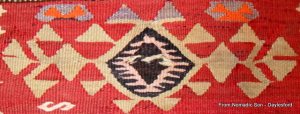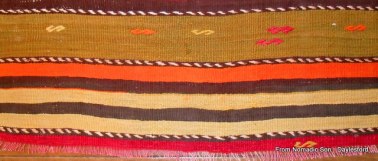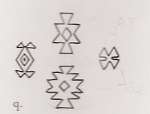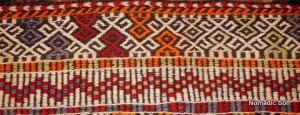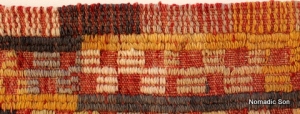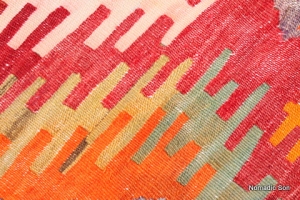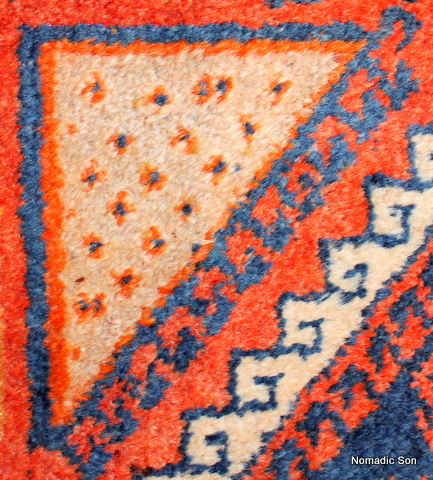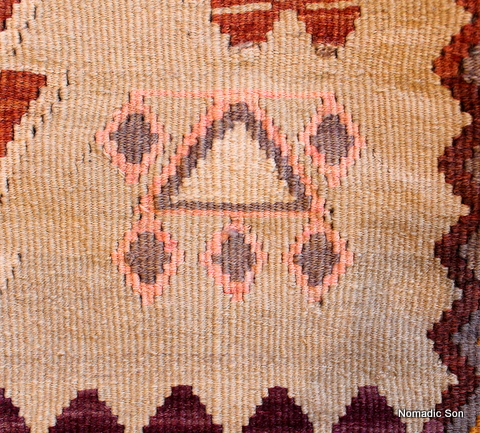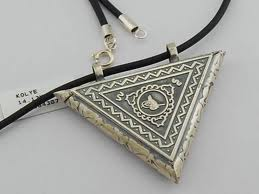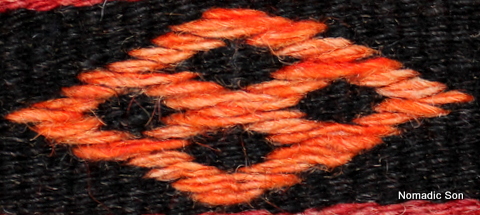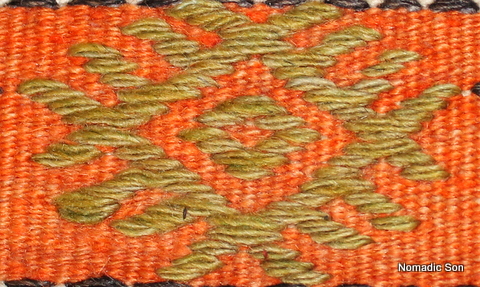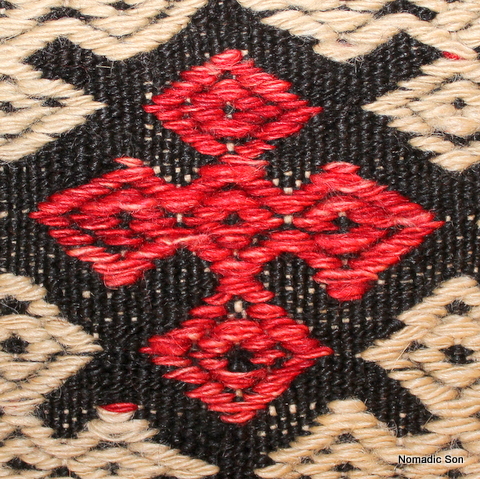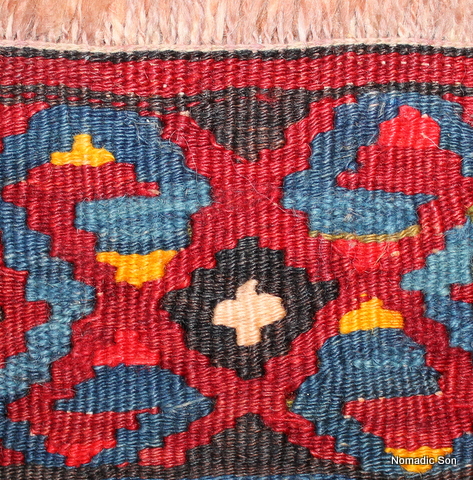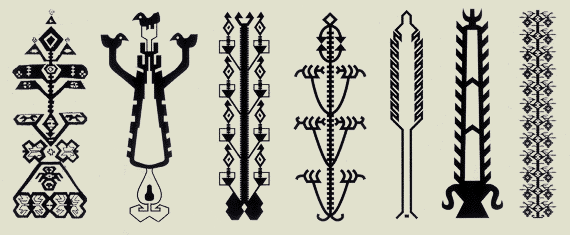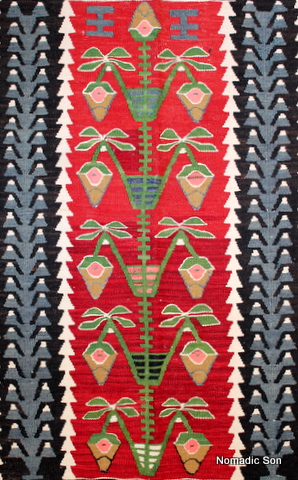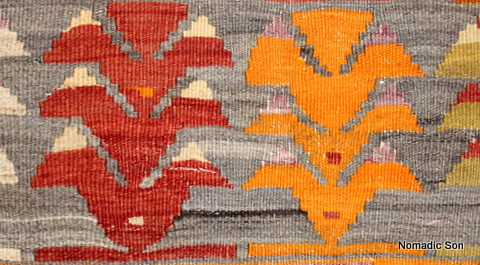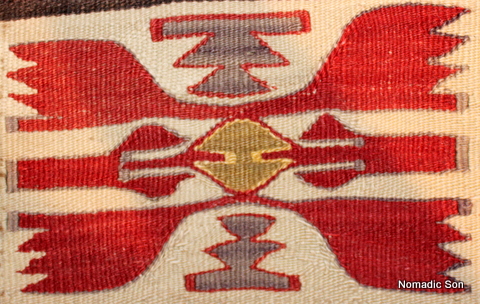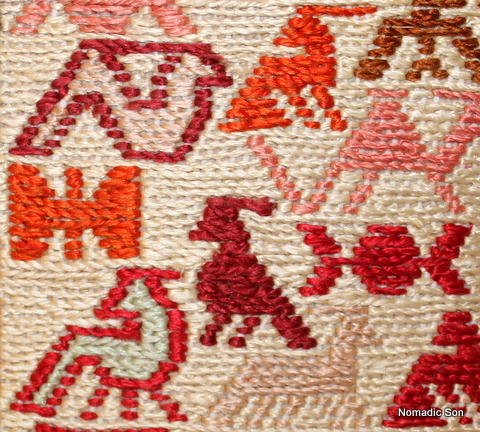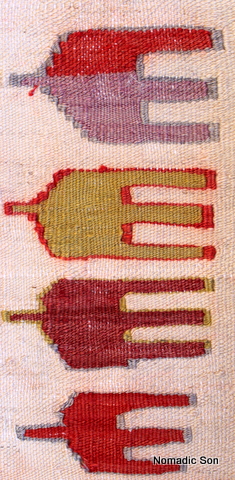Kilim, a word of Turkish origin, denotes a pileless textile of many uses produced by one of several flat weaving techniques that have a common or closely related heritage and are practiced in the geographical area that includes parts of Turkey (Anatolia and Thrace), North Africa, the Balkans, the Caucasus, Iran, Afghanistan, Pakistan, Central Asia and China.
The Turks have produced the largest kilims, usually in two narrow pieces joined, as well as small ones and a multitude of prayer kilims. As a prayer rug, which is carried about with the worshiper, the light and extremely flexible kilim offers obvious advantages. In Turkish kilims, cotton is often used for the white areas, and small details may be brocaded.
WESTERN ANATOLIA TURKISH KILIM RUG Follow Us on FACEBOOK
 KELES
KELES
Located in the north west part of Turkey, Keles produces fairly coarse slit woven kilims having tribal features. Keles kilims have subdued shades of reds, browns, blues and yellow. There are a broad range of prayer rug designs.

BALIKESIR
Located in the north west part of Turkey, Balıkesir is home of many tribes who wove glorious kilims. One of these tribes called Aydınlı tribe who used ancient and totemictic pattern. Some of these patterns are traced back to polished stone age. Balıkesir is also home kilims called saf where several praying niches are put side by side.
 SARKOY
SARKOY
Sarkoy kilims, decorated with tree of life and stylized birds, are woven in Bulgaria, Greece and the areas close to the Turkish Border. Birds and tree of life are the most prominent feature of these e kilims. Besides these motifs, human figures, stylized grape leaves, small praying niches and diamond designs are often encountered. Hooked diamond shaped medallions are also one of the major patters of Sarkoy kilims.
Designs on the Sarkoy Kilims are very stylized and abstract.
 BERGAMA
BERGAMA
Located in the north west part of Turkey, Bergama (ancient Pergamon) has been a great center for historical rugs and kilims. Bergama kilims always stayed very faithful to the traditional Seljuk designs and patters and contained geometrical paterns. Stylized tree of life, rams horn are often used on these kilims. Although blue and red are the dominant colors, we have also multi colored kilims woven in the area. Pair of hand pattern or comb design which appear in the center of the kilim are typical for Bergama kilims. Zili and Cicims, woven in Bergama region, have traditional crosses, surrounded by squares which symbolize a chest, signifying the weaver desire to get married. YUNCU
YUNCU
Located in Balıkesir region, Yuncu has been home of reputed kilims, woven with large and powerful ornaments since the 16th century. Most prominent feature of these kilims are the tree of life or a pole with ram horns emerging from it. Red, blue, dark green are dominant colors for Yuncu kilims which are woven mostly in square form and made smaller than Anatolian kilims. Yuncu kilims are dyed with madder roots (red color) and blue (indigo). Ram horn is the main pattern on the well-demanded kilims.

MANASTIR
Kilims woven in Gordes, Kula, Usak, Izmir, Akhisan were known as Manastır Kilims. These kilims with simple patterns draw our attention with very vivid colors such as red, yellow and blue colors. Geometric medallions, running dog patters and narrow bands with tiny crosses are typical patterns of these kilims.

USAK
Usak, the home of big size kilims is an important center for contemporary kilims. Old Usak kilims had often central medallion and red background color. Some of these Kilims are as big as 5.5 meter square. In the recent years, Usak became an important center for contemporary kilims.
 AYDIN
AYDIN
Aydın, located in the western Anatolia, is noted for prayer arch kilims and large kilims with two halves. Although Aydın kilims have some similarities with Konya Kilims, they have more infill motifs and they look busier then than Konya Kilims. Small squarish amblems repeated vertically , hooked motifs, large central medallions are typical for AYDIN Kilims. Some Aydın Kilims are distinctive with long narrow central mihrap surrounded by the series of strip like borders.

DENIZLI
Located in the western Anatolia, Denizli is the major center for contemporary kilims for export market. In besides these commercial kilims, Denizli region produces some very produces same authentic regional kilims. Having a great resemblance to Usak and Esme kilims, Denizli Kilims have rectangular sizes and feature bold serrated medallions in fairly bright colors.
 EŞME
EŞME
Located in the western Anatolia, the town of Esme produces both contemporary workshop kilim for export and some authentic regional kilims Esme Kilims, which have large medallions and amulet form, are decorated with small geometric and symbolic patterns all over them. most of the kilims, woven in Esme, have the slit weave technique and usually soft color such as pinks and grays. Because of their color combinations and fine weaving Esme kilims are much favored by the westerner. They often produce single or multiple hexagonal medallions. Whole ground of these kilims is filled with small and geometrical motifs. Most popular colors that Esme weavers use are pink, blue, yellow and orange. Small mihraps also appear on the Esme Kilims.
 FETHIYE
FETHIYE
Fethiye, located in the south west corner of Turkey, produces kilims with two major compositions. First category of these kilims has empty monochrome central medallion flanked by two heavily decorated end containing diamond designs. Second compositions offer a similar lay out. This time central field is filled various patters.
CENTRAL ANATOLIA TURKISH KILIM RUG

SIVRIHISAR
Sivrihisar, which is located in the west of Ankara, is noted for the kilims which use series of vertically stacked prayer arches( known as bacalı or chimney patter). Eli belinde patterns is also quite common design on these kilims.
 KARAPINAR
KARAPINAR
Karapinar, located in Central Anatolia, is noted for the production of good quality regional kilims featuring praying niche patters. Karapinar kilims, woven in the slit weave technique, feature primitive tribal character and appearance. They have pale ground color and darker colors for the patters.

KONYA
Located in the heart of Turkey, Konya is noted for its historical Turkish kilim rug. In our day, Konya region is great kilim weaving center with its contemporary workshops authentic regional weaving. Workshop kilims of Konya are woven in a variety of sizes, shapes, colors and designs which are aimed for the export market.
Regional kilims, which are woven in the slitweave technique and plainweave use a wide range designs and motifs. Central medallions, repeating geometric patters and all-over designs are most common.

KECIMUHSINE
Located in Central Anatolia near Konya, Kecimuhsine produces cicims in a unique patter based on cypress tree intersecting prayer arches. Kecimuhsine weavers use pale colors on the white or cream field. Having small size, Kecimushine cicims are highly collectable and fall into medium price range.
 KAYSERI
KAYSERI
Kayseri, once the capital of Cappadocia region, is an important kilim weaving center for regional and workshop kilims. It is noted for silk kilims which are made only in this region. Kayseri workshop kilims may range in price and quality from medium to high bracket. Besides the loosely woven kilims some much finer kilims are woven in the area. Colours used for the Kayseri kilims are often red, black, pink, gray.
Regional Turkish kilim rug tends towards a more subdued Palette colors such as orange, yellow, brown and white. Paneled or banded compositions or very intricate designs all over patterns are used. Since the quality of the material and weaving varies considerably, it is important to judge all kilims from Kayseri region on their individual merits.

MALATYA
Located in the eastern part of Turkey, Malatya is noted for workshop kilims and regional kilims of fine quality. Malatya Kilims have limited number of designs, especially for the big size of Kurdish Kilims. As to small size prayer kilims, there is more variety of designs are motifs.

MUT
Mut village, located on the Taurus mountains of southern Turkey, is a center for nomadic and semi nomadic tribesmen. Mut weavers made kilims with tribal appearance and significant amount of wool, goat and horse hair. Designs are mainly bold and based on serrated and hexagonal medallions in a variety of repeated and interconnected designs.

NIGDE
Located on the major trade roads, Nigde is noted for the fine quality of Turkish kilim rug which often feature serrated hexagonal motifs in complex.

OBRUK
Renowned for its finely woven prayer kilims rugs( often decorated with tree of life), Obruk also produces cicims with the geometric forms ( medallions banded designs and interconnecting diamonds)of Turkish kilim rug.
Obruk color palette varies from the bright to dark with the dominance of reds, blues, yellows, orange and white.
SOUTH EAST ANATOLIA TURKISH KILIM RUG
 GAZIANTEP
GAZIANTEP
Situated in the south eastern part of Turkey, near the Syrian Border, Gaziantep was once the home of very fine kilims. Although Gaziantep doesn't produce a great number of Turkish kilim rug today, old Anteps still appear on the market. Woven in the slit weave technique, Gaziantep kilims feature diamond designs (central diamond flanked by two smaller ones). and six pointed stars. Gaziantep kilims have horizontal bands with various colors. The ying yang design (symbolizing the harmony), scorpion and eli belinde designs appear on the Gaziantep kilims. These very elaborate patterns are often highlighted with a white cotton for special effect.
EAST ANATOLIA TURKISH KILIM RUG
 ERZURUM
ERZURUM
Erzurum, an important city on the ancient caravan route between Anatolia and Iran, is noted for its praying kilims which are made bigger than those woven in the other parts of Anatolia as Turkish Kilim Rug. Wolf track and wolf mouth motifs are used as border pattern on these kilims. Tree of life design, which is also one of the favorite pattern of Erzurum flat weaving, is used as a border design and central motif, located in the center prayer arches. One can see also double ended prayer niches.

TURKISH KARABAG
The kilims, which have dark backgrounds in black or deep brown and big floral patterns in reds, pinks and orange, are made in the Erzurum Region in the last forty years known as Turkish Karabags. These kilims with big flowers are influenced by Karabag Kilims of Caucasus. These Turkish kilim rug with white and beige colored borders have long and narrow sizes.

SIVAS
Sivas, large town in the east part of Turkey, was once the important center on the trade roads. Because of its mixed population, Sivas Kilims show the influence of both etnique groups. Comparing to Turkish Kilim Rug woven in the eastern Turkey, Sivas Kilims have lighter colors with the predominance of bright red, orange, pale green, cream and white colors. Small prayer rugs, safs are common. Large Sivas kilims, which have central or repeating medallions, are finely woven and they use good quality of wool. Leaf and wine motif is often used on the border of Sivas Kilims.
KARS
Kars, which is a major town on the Turkish Armenian border, produce kilims with Kurdish and Caucasian influence. Turkish Kilim Rug, made in the Kars region, feature a great variety of praying arches, repeating medallions and geometric compositions. The quality of these kilims and their patters change from very simple tribal designs to sophisticated and complex patters. Kars kilims having dark colors don't suit to western furnishing demands. Kars Kilim, produced in the recent times tend to use softer palette of colors such as browns, pinks. orange and white.

VAN
Van, major town in the eastern part of Turkey, is noted for its high quality kilims. It also acts an important marketing center for the Kurdish tribes. Main composition of Van Kilims based on large Hooked or crenellated diamond designs or on traditional banded patters using great deal of geometric infill motifs. Van kilims have pallette of dark colors with the predominance of red, blue, brown, green, yellow and white.
The products of two largest Kurdish tribes Herki and Hartushi are sold in Van region. The weavers of Van use metallic thread a lot.
Means of Kilim Motifs
Fetter: (used as a Horse or camel cuff) When woven, used to symbolise family unity and staying together.
Wolf print/mouth: Protection from wolves/wild animals. Understandable given the damage that a wolf could do to the nomadic tribes flock and hence entire lifestyle.
‘Wolf print/mouth’ motif an a naturally dyed antique Cal Kilim (#068)
Earring: Desire to marry. Earrings and other gold items were and still are a common and desirable wedding gift.
Hair band: Desire to marry. Hair bands form an important ornamental decoration during the wedding ceremony.
‘Earring’ & ‘hair band’ motifs on ends of Old Fethiye Runner (#88)
Chest: Desire to marry. A young brides dowry and belongings often packed into the chests and transported for her new marriage.
‘Sandik’ or ‘chest’ motif covering entire main field of an antique Fethiye Runner (#M9)
Ram’s horns: Fertility, heroism, power and masculinity. I have also seen it referred to as ‘leadership’ in relation to Turkish kilims.
Prominent ‘rams horn’ motif on an old Konya cicim kilim (#142)
Elinbelinde (hands on hips): Female strength, fertility, motherhood. This is one of the oldest Anatolian motifs and a source of great interest to those that subscribe to the ‘Mother Goddess’ theory regarding the origin of Anatolian kilims.
Interlocking and repeating ‘hands on hips’ motif covering the entire main field of this Denizli cicim kilim (#046)
Scorpion: Protection. It is not unique to Anatolian tribes to use the object’s image that will provide protection from it.
Çapraz (S motif): Said to act as a talisman, protection. An extremely common motif in Anatolian kilims, sometimes described as a ‘hook’ motif or ‘s’ motif.
Random filler motifs of ‘Capraz’ (hooked shape/s on a Daskiri Runner (#M15)
Nazar (evil eye): Protection. With history dating back to Mesopotamia, Anatolian people certainly do not have a monopoly on the evil eye. It is said to provide protection against people’s jealousies and ill wishes.
‘Nazar’ motif on an antique Usak Esme kilim (#115)
Burdock (thorn): Thought to provide protection and also for ‘abundance’.
Variations of the motifs is common and wide-spread; different areas and the passage of time has resulted in diffferent formed motifs being used throughout Anatolia.
Star: Generally thought to mean happiness. Although some believe it to represent the womb, hence it could also be a fertility motif.


Running water: Since all life is dependent upon water, it is a widely used motif thought to represent life. It is interesting to note that what we call ‘borders’, weavers call them ‘springs’ or ‘streams’.
Hand, finger, comb: Protection of marriage and birth from the evil eye (other people’s jealousies and ill wishes). During the Islamic period, the use of a 5 fingers or hand motif was used to represent ‘hand of .
Fatma’ (Mother fatdime)
The comb motif is thought to be woven when expressing a desire to get married and give birth and wishing also for protection for these events.
Muska: (Amulet) A triangular motif, supposed to have magical properties, derived from the shape of a pouch used to carry Koranic inscriptions or religious or shamanistic relics.
Muskas are still in use today carrying Koranic inscriptions usually on a leather necklace.
Eye: Again, a protection motif to ward off other people’s ‘evil’ glances. Can come in various forms depending on the region.
Cross: Protection yet again. It is thought that the cross, in its various forms divides the evil into smaller parts. The motif has been in long use prior to Christianity.
 Tree of Life:
Tree of Life: The tree is the common theme for all religions believing in one God. In all 3 religious scriptures (Torah, Bible and Quran) the fruit which is believed to bring immortality, is forbidden to all mortals when the serpent (Satan) convinced Adam and Eve to eat it. Mankind, unable to eat the fruit of immortality, put all their hopes on the life after death symbolized by a tree of life.
Bird: No other motif has so many varied meanings as the bird motif to the Anatolian weavers. Bad luck, good luck, the symbol of happiness, joy and love. But also the soul of the dead. It is longing, and expectation of news. It can also stand for power and strength.




















































